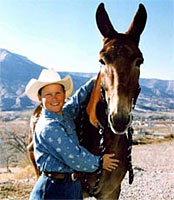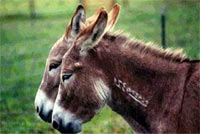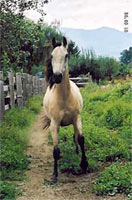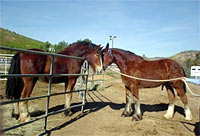 Horse Information Lives Here! ©
Horse Information Lives Here! ©
John Lyons Certified Trainers are Here
Help Support The PMU Foal Adoption Network Inc.

Fixing the Buddy Sour Horse
by Monica Erman 
It’s stressful, nerve wracking and scary. We try not to worry when our horse in
the pasture or pen goes bonkers in the field as we lead away his favorite buddy. Hopefully he won’t go through the fence or run himself sick, we think. There must be a way to fix this problem. There is.
 Most of the time the horse left behind is the one that throws the
bigger fit. But sometimes the one we are leading gets dangerously out of control. We can build a lesson plan to help both of these horses. We’ll talk about the horse left in the
pasture first, then explain some ways to quickly regain control of the horse we are leading away.
Most of the time the horse left behind is the one that throws the
bigger fit. But sometimes the one we are leading gets dangerously out of control. We can build a lesson plan to help both of these horses. We’ll talk about the horse left in the
pasture first, then explain some ways to quickly regain control of the horse we are leading away.
For the horse left at home. . .
 Many a horse has driven himself into an anxiety fit when his buddy is taken
away. Horses are herd animals and a huge part of their mental and psychological health comes from being with other equines. While horses can learn to live by themselves, thanks to their wonderful adaptability,
asking them to be comfortable with solitude right from the beginning can be risky to their health and our facilities!
Many a horse has driven himself into an anxiety fit when his buddy is taken
away. Horses are herd animals and a huge part of their mental and psychological health comes from being with other equines. While horses can learn to live by themselves, thanks to their wonderful adaptability,
asking them to be comfortable with solitude right from the beginning can be risky to their health and our facilities!
The key is repetition. When we take our horse’s buddy away from him, he
is going to get excited. Most of the time we only take the buddy away once and the horse gets upset and may stay upset for the duration of the buddy’s absence. We need to give our horse the time and opportunity to
get comfortable with seeing his buddy leave. By practicing leaving with the buddy, the horse in the pasture can get accustomed to the fact that his buddy is going to leave, but he will come back. Put the horse in a pen or pasture in which he is safely confined.
No wire fences. Halter the buddy and start to lead him away from the horse. Watch the horse as you leave. Go just far enough for the horse to see that his buddy is leaving, then lead
the buddy back to the fence and let them reunite. Allow them to stay together until every one’s heart rate is back to normal, then lead the buddy away again. Before the horse gets too
upset, return for another reuniting. Keep practicing this leave and return pattern until you can leave for longer periods of time. The more times you repeat this
exercise, the better. Eventually the horse will understand that not only is his buddy going to leave, but the buddy will return so there is no need to put himself through the emotional stress.
Put the horse in a pen or pasture in which he is safely confined.
No wire fences. Halter the buddy and start to lead him away from the horse. Watch the horse as you leave. Go just far enough for the horse to see that his buddy is leaving, then lead
the buddy back to the fence and let them reunite. Allow them to stay together until every one’s heart rate is back to normal, then lead the buddy away again. Before the horse gets too
upset, return for another reuniting. Keep practicing this leave and return pattern until you can leave for longer periods of time. The more times you repeat this
exercise, the better. Eventually the horse will understand that not only is his buddy going to leave, but the buddy will return so there is no need to put himself through the emotional stress.
For the horse leaving home. . .
Since we have (or at least should have) more control of the horse on the lead than the one left at
home, we have a better chance of influencing the led horse’s emotions. Just as an experienced babysitter will quickly distract an upset child from his desire to go with Mom, we can distract the
horse or ask him to respond to us. If he is trained to respond correctly to our cues, we can change his actions and pretty soon his emotions.
Sometimes our horse is so attached to a buddy that asking him to leave is just asking for a wreck. We can treat this basically the same way we helped teach the penned horse to accept his buddy’s departure; leave and return.
But we won’t spend time simply standing next to the buddy. Now we are going to
be busy asking him to do things like go left, stop when we stop, trot forward, back up, etc.
As we practice his ground control and manners, we’ll watch his emotional state. If he gets too
excited, go closer to the buddy and keep practicing while he calms down. (If the buddy won’t stay close to the fence, tie him on the opposite side of a safe fence. That way you won’t have
added anxiety if the buddy decides to go find something more interesting out in the middle of the field.) We gradually work our way away from the horse in the pen. The more times we leave and return, the better.
These exercises can be done from the saddle. Keep your safety first and remember to allow yourself sufficient time for repetitions at gradually increasing distances, so the lesson can be effective.
Contact: Monica Erman
155 German Hill Road
Tunkhannock, Pennsylvania 18657
Phone: 570-836-2217
Email: mule_trainer@yahoo.com
[Home], [Articles], [Academic Schools], [ARICP Trainers], [Animal Communicators], [Barn and Accessories], [Books and Videos], [Breeders], [Career Schools], [Clinicians], [Fencing], [For Sale], [Footings], [Freeze Branding] [Gifts], [Health and Nutrituon], [Horses for Sale Online], [Instructor Certification], [Insurance],
[John Lyons Certified], [Lawyers], [[ Links]], [Health] [Horse Property Specialists],
[Portable Stalls Areanas and Roundpens], [Richard Shrake], [Riding Schools], [Schools], [Shipping], [Software], [Specialty Trainers], [Summer Camps], [Tack], [Trainers], [Trailers], [Vacations]
InfoHorse.com...Horse Information Lives Here ® 12/12/2025
Contact Us to Advertise to almost a million Horse Owners
All images and content Copyright©2003 by InfoHorse.com/Equusite.com